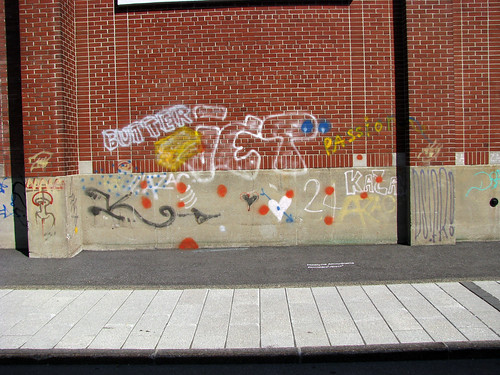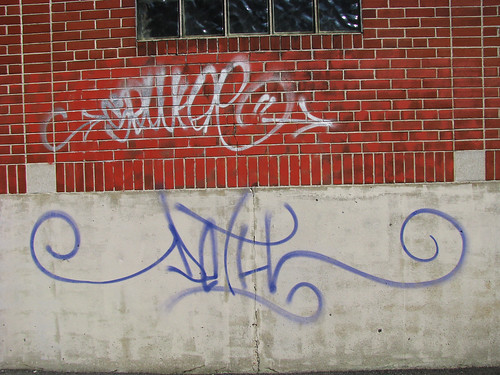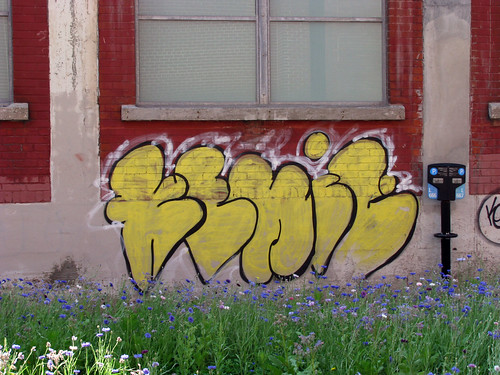Awhile ago, I wrote about some of the odd things surrounding the Darling Foundry on Ottawa Street in Griffintown. Along with being an excellent space for emerging artists, the area around the foundry has been dubbed the “Quartier éphémère” where various events and interventions have been happening. Last summer, the block of Ottawa Street in front of the Foundry was shut down to traffic and a garden of sorts was planted on top of the pavement. My favourite part of the Foundry, however, is the graffiti on the walls of the old industrial buildings surrounding it. Although the quality of this graffiti tends not to be as high as in other areas of the city, I’ve always liked it because it’s so different and more artistic than what is seen elsewhere. Below are some photos I took of it last summer while I was lucky enough to live only a couple blocks down the street. (click on photos for a larger view)
Darling Foundry graffiti
By Chris Erb
Read more articles by Chris Erb








11 comments
Ew! I like graffiti but most of that is crap.
Time to hold an ‘Under Pressure’ in Cité Multimédia?
As a trustee of the Darling Foundry, I am glad for this superb documentation of street art that was soon to be lost forever, thanks to the cleaning zeal of city employees who saw in it nothing but dirty smudges. They even thought they were doing the Foundry a favor last Fall when they painted over the graffiti on its buildings’ walls (as opposed to the ones across the street shown here, on a Hydro building). They failed to realize who they were messing with: the Darling Foundry’s …founder, and artistic director, Caroline Andrieux, wrote her Sorbonne thesis on graffiti art, and is acting as a mécène of sorts in welcoming it on all surfaces in its surroundings. She was appalled by this unilateral surprise action, and immediately lodged a protest with the city, turning the tables on it by portraying this “cleaning” of street art as vandalism and a defacement of private property, when it came to Foundry buildings at least. The city has responded apologetically, and there is talk that it will remove the layer of brown paint it put over the Foundry’s spontaneously ornamented bricks…
This is not art, it’s property damage. If you like graffiti so much why don’t you post your address or the location where you park your car? I’m sure some of the local “artists” would be happy to improve your property for free.
All graffiti is filth.
Glad to see BdgBill has such an open mind. ;) I like how he doens’t like the anonymity of graf artists but is more than willing to use a pseudonym for his name. Irony….
Anyway, not all graffiti is “filth”. There is such a wide-range of graffiti out there that it cannot be all lumped together. Saying all graffiti is filth is like saying all music is bad. Some music is bad, but certainly not all.
The idea that all graffiti is bad, and that it even scares away business, is a myth. Much like city life, there are tonnes of grey areas between good and bad and not everyone will like what happens. I find highways filthy and have a much more destructive force on a city than something like graffiti, but I won’t call for the total abolition of cars. I know vehicles are important to our cities and play important roles in our lives.
Furthermore, how is it “property damage” when the building owners want and encourage graffiti on their building?
@Matthew Blackett
It is not the anonymity of graffiti criminals that bothers me. It’s the fact that they are damaging other peoples property. Why is this so hard to understand? The artistic merit of this damage means nothing. Painting a picture on someone elses building without permission is no different from me spray painting my name on your car.
You state that it is a myth that graffiti scares away businesses. I can tell you with a high degree of certainty that this is false.
I work for a large national retailer that spends thousands of dollars per store per year removing hateful scrawlings from building walls, replacing windows damaged by acid and closing public restrooms due to repeated damage. When we scout areas for new stores the presence of graffiti and roll down security shutters on businesses is enough for us to pass on a neighborhood.
@Chris Erb
You state that building owners “want and encourage graffiti on their buildings”. In your wildest fantasies, do you imagine that more than 1% of graffiti victims are happy with the damage done to their property? I doubt it.
In the last few years a fad has emerged where some galleries are “discovering” unknown “street artists” and pulling them into the mainstream. This only encourages the hordes of cowardly, marker toting miscreants to leave their droppings in a hundred different places a day.
I encourage Montreal in their “cleaning zeal”. I would like to see a NY style “Graffiti Squad” in the city to focus on arresting graffiti criminals. I was thrilled when Shepard Fairey was arrested in Boston the other day.
Well, BdgBill, you’re certainly entitled to your opinion on graffiti, however I definitely would not want to live in your ideal city. I think it would be the most boring, sterile, and miserably bland place on earth.
The last thing I want in my neighbourhood is a “large national retailer” so, for me, graffiti in my neighbourhood is completely positive in that it is visually stimulating, adding colour to otherwise boring surfaces and scares away undesirable business that will only push out small business and sterilise my local commercial streets.
Also, my remark concerning building owners who “want and encourage graffiti on their buildings” was in reference to the Darling Foundry where these pictures are taken and a trustee defended the graffiti that was put on their building and subsequently erased (vandalised?) by the city.
I’m going to assume that (with the exception of Christian Roy) most of the pro-graffiti people here don’t own a residential or commercial property. It’s pretty easy to be all for graffiti when you’re not in any position to have to deal with its consequences. I’m guessing this would probably change if they were the ones who had to directly pay for its removal rather than their landlords or local business owners.
I also think that cities like Montreal can do well enough on its own without the beautification that some claim graffiti brings. I agree that certain areas of Montreal have a tendency to be a bit on the grey side on account of all its concrete and limestone, but I’ve never felt the need to change all that by painting over things with garish colours. If you believe that a graffiti-less environment would create “the most boring, sterile, and miserably bland place on earth” then I don’t really know what to say. Maybe try visiting some other cities around the world for a change.
Most of this is quite ugly. If the owner wants it then that’s great, and I agree that the government should not risk the materials of a building’s walls without asking the owner for a permission to clean them. However, vandals should stay away from buildings whose owners don’t want graffiti and thank these opportunities.
On the other hand, Chris, if graffiti vandalism were about beautifying boring walls, that would be great, but you seem to be really ignorant on the subject. Most of it is entirely about self promotion, and shows no interest in aesthetics whatsoever. Some graffiti vandals are great artists though, but that is rare.
@ Adolfo: “Some graffiti vandals are great artists though, but that is rare.”
That goes for the Art world as well.
@Andrew. I own a house. I had kids tag my fence. I painted over it. No sweat, really. I expect it to happen and have control over it when it does happen.
@BldgBill: You sound like you want a nice, clean Fascist city. To each their own. I’d rather have a more vibrant city where lots of things happen, even bad things, graffiti being one them. I don’t want to live in Pleasantville. And I know of other businesses who have moved into neighbourhoods with graffiti because they know that the area is not being white-washed, and attracts different types of people.
I don’t like much of the graf out there either, especially tags, but I also think the outdoor advertising of national retail chains like the one you work for are just as much of a blight. Your company never asks the public if they want their visual (and public) environment changed, so I can see why graf artists treat private property with the same disdain. If you look at Illegalsigns.ca you’ll see that the outdoor ad industry is a much worse culprit when it comes to defying the laws of a city’s streetscape.
There’s a bit of difference between merely painting over a fence to get rid of graffiti and having to sandblast an entire wall or replace a window to get rid of etchings.
This advertising-is-worse-than-graffiti argument is also pretty silly and cliché at this point. Last time I checked, property owners haven’t had a problem waking up and finding that the walls outside their house smothered in Gap ads. If they did, I’m pretty sure they’d be far easier and cheaper to remove than the damage that’s left from a spraycan. I don’t think most people view billboards with that much disdain to begin with, do they?
I’m not against the idea of graffiti or the idea that it can help make a city look more interesting. There are some areas of Montreal where it has added a nice touch. I just hate it when people try to rationalize it without thinking of the adverse effects it can have for those who actually have to deal with it. You know.. the ones who can’t simply solve the problem just by putting a fresh coat of paint over it?
It’s also annoying how this has to be so black and white. Apparently if I’m opposed to graffiti then it means I only want to live in Pleasantville? Give me a break.